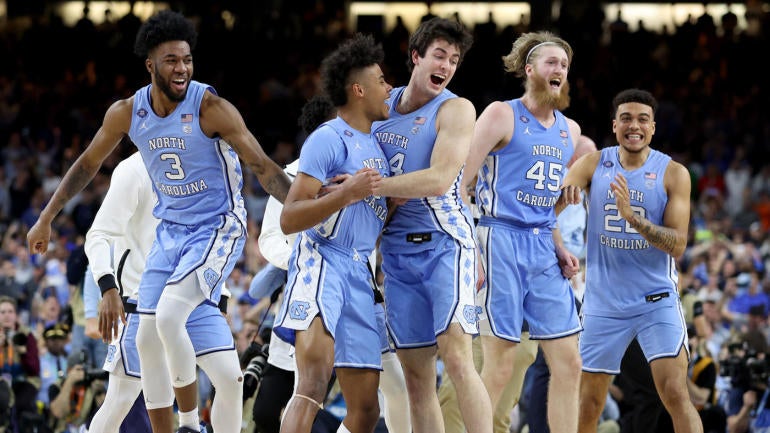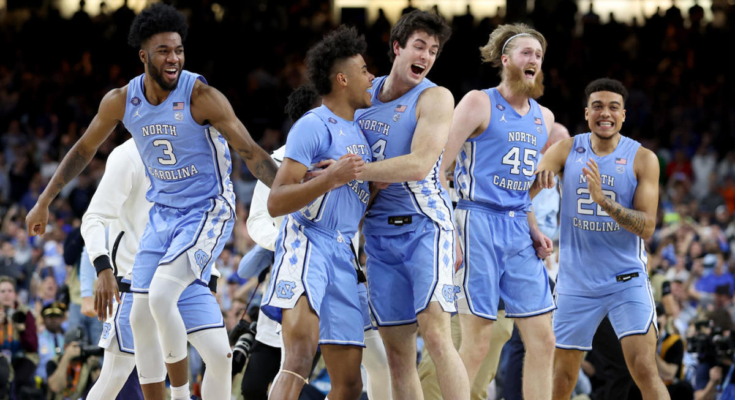
An epic night on Saturday in the Final Four has given us an all-time national championship game with No. 1 seed Kansas facing No. 8 seed North Carolina in the final game of the 2022 NCAA Tournament on Monday night.
Kansas, the only No. 1 seed to advance to the Elite Eight, took care of business in a wire-to-wire win against No. 2 seed Villanova in the first game on Saturday night. The Wildcats made several runs at the Kansas lead, but some combination of Ochai Agbaji, David McCormack and Christian Braun stepped up with an answer to every Villanova run, leaving no doubt in the game’s closing minutes. Both coaches emptied the benches and Kansas turned its attention to the its first national championship game appearance since facing Kentucky in the same New Orleans setting in 2012.
The first-ever meeting of North Carolina and Duke in the NCAA Tournament brought so much hype that you could almost blame the excitement for the poor shooting by both teams early in the game. But after about 10 minutes, the back-and-forth was on and the rubber match between the Tobacco Road rivals delivered just as much anyone could have hoped. The 18 lead changes and 12 ties brought all the intensity of college basketball’s best rivalry to the game’s biggest stage, but it was Caleb Love’s clutch play that propelled the Tar Heels into the national championship game.
Kansas and North Carolina have met several times before in the Final Four, including in the 1957 national championship game, the 1991 national semifinal, the 1993 national semifinal and the 2008 national semifinal. Here’s how each side stacks up against each other heading into Monday night:
(1) Kansas Jayhawks
Midwest Regional Champion
- Record: 33-6
- Final Four appearances: 16 (1940, 1952, 1953, 1957, 1971, 1974, 1986, 1988, 1991, 1993, 2002, 2003, 2008, 2012, 2018, 2022)
- NCAA titles: 3 (1952, 1988, 2008)
- NCAA Tournament path: First round — Def. No. 16 Texas Southern 83-56; Second round — Def. No. 9 Creighton 79-72; Sweet 16 — Def. No. 4 Providence 66-61; Elite Eight — Def. No. 10 Miami 76-50; Def. No. 2 Villanova 81-65.
- Coach: Bill Self is making his fourth appearance in the Final Four as a coach, all of them coming with the Jayhawks. He won it all on his first visit in 2008, finished as a runner-up to Kentucky in 2012 and was eliminated from the national semifinals by eventual champion Villanova in 2018. With 16 Big 12 regular-season titles across his 19 years with the program, Self has established a model of regular-season consistency that is unmatched across the sport.
- Best player: Ochai Agbaji. The Big 12 Player of the Year does a little bit of everything for this team. He can step outside as one of the team’s best three-point shooters or drive the lane to make a play at the rim. On defense he can be an effective on-ball defender, defensive rebounder or take off on the fast break to make a play in the open floor when Kansas wants to push the tempo.
- Strengths: This is an experienced team playing with a ton of confidence, trotting out four seniors, a junior and two sophomores in their seven-man rotation. Two of those seniors have the potential to be the best player on the floor, but we have yet to see them star at the same time. Agbaji was the Big 12’s leading scorer, the Big 12 Player of the Year and an All-American, but the tournament has seen the emergence of transfer guard Remy Martin, who was named the Most Outstanding Player in the Midwest Regional despite coming off the bench as a sixth man and missing most of February with injury issues. Both players are not just capable scorers but key pieces in Kansas’ perimeter defense, which will be an x-factor for success in the Final Four.
- Weaknesses: After a stellar showing in the Big 12 Tournament, the Jayhawks have been a little bit streaky in the Big Dance. The single-digit wins against both Creighton in the second round and Providence in the Sweet 16 had some tense moments, but it was allowing Miami to jump out to a 35-29 halftime lead that really brought those consistency concerns to the spotlight. Of course, this veteran Kansas team responded by outscoring the Hurricanes 47-15 over the final 20 minutes. But if you’re looking for weaknesses in this experienced and well-rounded team, it’s that we’ve yet to see a full 40 minutes of its best basketball in the tournament.
- Key number: 0. Every other team in the Final Four has at least one former five-star prospect on the roster, and the Jayhawks do not have any. Self and experts everywhere have frequently started analysis with some version of the phrase “this might not be Kansas’ most talented team, but …” before heaping praise on the 32-win Jayhawks. it’s odd for a program that has signed numerous five-star prospects and produced dozens of NBA players to be one of the least talented teams in the Final Four, but the makeup of this squad — which, for the record, does have 10 former four-star prospects — might be just what they needed to get back to the Final Four and perhaps win another national championship.
- Outlook: The loss of the 2020 NCAA Tournament is not a primary motivation for Kansas, but it’s not lost on anyone around the program that Self and the Jayhawks had the best team in the country at the time that the tournament was canceled because of the COVID-19 pandemic. Agbaji, David McCormack and Christian Braun were all part of that team and in this tournament have seen the bracket break their way at nearly every turn.
(8) North Carolina Tar Heels
East Regional Champion
- Record: 29-9
- Final Four appearances: 20 (1946, 1957, 1967, 1968, 1969, 1972, 1977, 1981, 1982, 1991, 1993, 1995, 1997, 1998, 2000, 2005, 2008, 2009, 2016, 2017)
- NCAA titles: 6 (1957, 1982, 1993, 2005, 2009, 2017)
- NCAA Tournament path: First Round — Def. No. 9 Marquette 95-63; Second Round — Def. No. 1 Baylor 93-86 (OT); Sweet 16 — Def. No. 4 UCLA 73-66; Elite Eight — Def. No. 15 Saint Peter’s 69-49; Def. No. 2 Duke 81-77
- Coach: Hubert Davis is the first head coach since Bill Guthridge (at North Carolina in 1998) to lead his team to a Final Four in his first year. The successor to Roy Williams got off to a rough start to the season, starting 12-6 overall without a notable non-conference win and 4-3 in ACC play, but the Tar Heels’ strong close to the season moved this team off the bubble, into the field and now all the way into the Final Four.
- Best player: There has been a stylistic shift in North Carolina’s lineups with the transition from Roy Williams to Hubert Davis, but he’s maintained at least one traditional big that can run the floor with Armando Bacot. It would be a poor decision to not let one of the best rebounders in the country see as much time on the floor as possible, but it’s been interesting to watch how Bacot has also adopted modern roles in the offense. He’ll start at the perimeter and float into the lane, giving him the option to either drive to the basket or kick out to one of North Carolina’s capable 3-point options if the defense collapses. Scorer, rebounder and facilitator are all in Bacot’s wheelhouse, which is why he’s the best player on the floor.
- Strengths: North Carolina has four players capable of scoring 20-plus on any given night, and that versatility of scoring options make them a dangerous team to face in terms of game planning. In this tournament alone we’ve seen guards Caleb Love and RJ Davis each score 30 points, Brady Manek has scored 26 or more twice and Bacot has had a double-double in every postseason game (ACC Tournament and NCAA Tournament) the Tar Heels have played this year.
- Weaknesses: The lack of competitive depth was on full display during the near 30-4 run by Baylor in the second half of what would eventually be an overtime win for the Tar Heels in the second round. After Manek was ejected midway through the second half and Love’s foul trouble caught up to him before the end of regulation, the Tar Heels’ depth issues and matchup problems against elite teams beyond its starting five were on full display. Much has been made of the “Iron Five” who carry so much of the playing time weight and played every minute of the second half in the win at Duke, but the other side of the “Iron Five” is a drop-off in experience and performance should one of those five be knocked out of the game.
- Key number: 39.1%. That’s the 3-point percentage from North Carolina’s win against Duke in Cameron Indoor Stadium. It’s just a few ticks above the Tar Heels’ respectable season average of 36.1% but in that increase you may find what North Carolina needs to beat Duke again on Saturday night in the Final Four. While North Carolina has improved defensively in the month of March, it’s best course of action will not be to rely exclusively on defensive stops to win against the high-powered Blue Devils. Timely defensive stops, sure. But North Carolina has to hit threes to keep up on the scoreboard and give itself a chance to win late.
- Outlook: According to BartTorvik.com, where you can not only check out season-long adjusted efficiency numbers but also sort the data set by date, North Carolina is the No. 1 team in the country in adjusted offensive efficiency since March 1. The seven-game run is absolutely up for critique because of the small sample size, but it backs up what our eyes have told us as well. North Carolina may not be the absolute No. 1 team in the country right now, but it’s been playing as well as the best teams in the country since the calendar turned from February to March. The Tar Heels are a No. 8 seed in the tournament but the quality of play represents a team that does not check in as the No. 29 to No. 32 team in the field of 68. Still, the task of winning the next game is the largest at hand.


